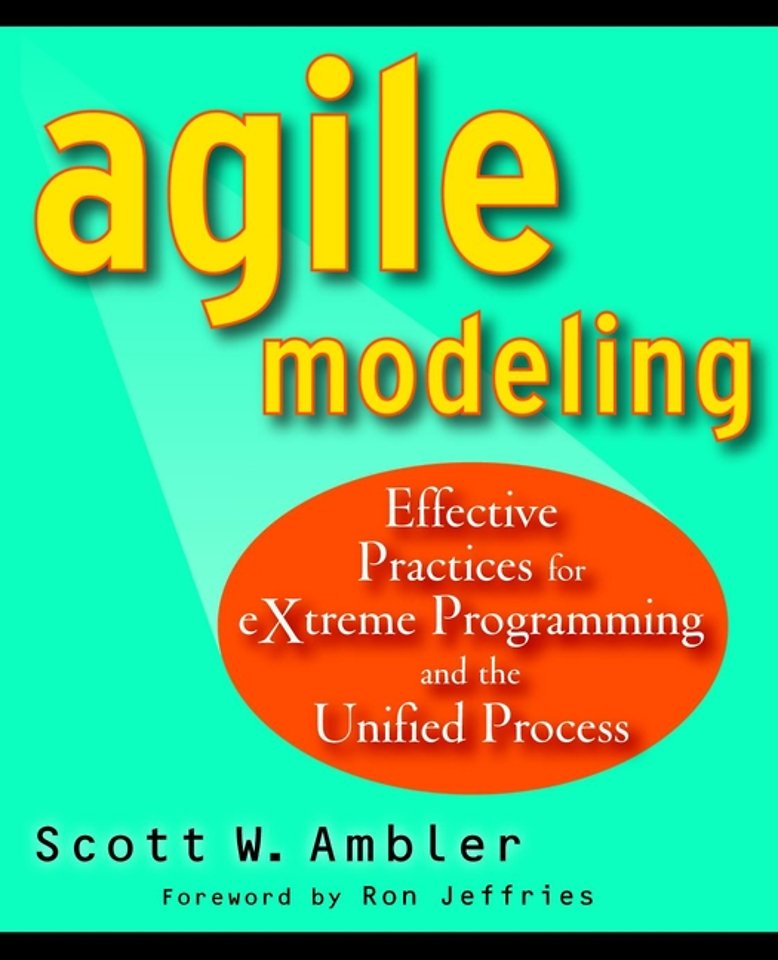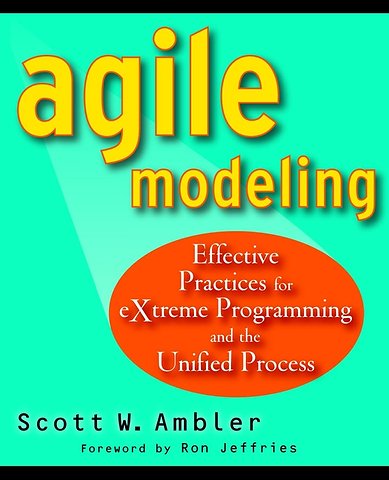Agile Modeling – Effective Practices for Extreme Programming and the Unified Process
Effective Practices for eXtreme Programming and the Unified Process
Paperback Engels 2002 9780471202820Samenvatting
The first book to cover Agile Modeling, a new modeling technique created specifically for XP projects eXtreme Programming (XP) has created a buzz in the software development community–much like Design Patterns did several years ago. Although XP presents a methodology for faster software development, many developers find that XP does not allow for modeling time, which is critical to ensure that a project meets its proposed requirements. They have also found that standard modeling techniques that use the Unified Modeling Language (UML) often do not work with this methodology. In this innovative book, Software Development columnist Scott Ambler presents Agile Modeling (AM)–a technique that he created for modeling XP projects using pieces of the UML and Rational′s Unified Process (RUP). Ambler clearly explains AM, and shows readers how to incorporate AM, UML, and RUP into their development projects with the help of numerous case studies integrated throughout the book.
AM was created by the author for modeling XP projects–an element lacking in the original XP design
The XP community and its creator have embraced AM, which should give this book strong market acceptance
Companion Web site at www.agilemodeling.com features updates, links to XP and AM resources, and ongoing case studies about agile modeling.
Specificaties
Lezersrecensies
Inhoudsopgave
<p>Preface xiii</p>
<p>Part One Introduction to Agile Modeling 1</p>
<p>Chapter 1 Introduction 3</p>
<p>Enter Agile Software Development 6</p>
<p>Agile Modeling 8</p>
<p>The SWA Online Case Study 17</p>
<p>A Brief Overview of this Book 18</p>
<p>Chapter 2 Agile Modeling Values 19</p>
<p>Communication 20</p>
<p>Simplicity 21</p>
<p>Feedback 22</p>
<p>Courage 23</p>
<p>Humility 25</p>
<p>Beyond Motherhood and Apple Pie 26</p>
<p>Chapter 3 Core Principles 27</p>
<p>Software Is Your Primary Goal 28</p>
<p>Enabling the Next Effort Is Your Secondary Goal 28</p>
<p>Travel Light 29</p>
<p>Assume Simplicity 29</p>
<p>Embrace Change 30</p>
<p>Incremental Change 31</p>
<p>Model with a Purpose 31</p>
<p>Multiple Models 32</p>
<p>Quality Work 34</p>
<p>Rapid Feedback 35</p>
<p>Maximize Stakeholder Investment 37</p>
<p>Why Core Principles? 37</p>
<p>Chapter 4 Supplementary Principles 38</p>
<p>Content Is More Important Than Representation 38</p>
<p>Everyone Can Learn from Everyone Else 41</p>
<p>Know Your Models 41</p>
<p>Local Adaptation 42</p>
<p>Open and Honest Communication 42</p>
<p>Work with People s Instincts 42</p>
<p>Benefiting from These Principles 43</p>
<p>Chapter 5 Core Practices 44</p>
<p>Practices for Iterative and Incremental Modeling 45</p>
<p>Practices for Effective Teamwork 52</p>
<p>Practices That Enable Simplicity 56</p>
<p>Practices for Validating Your Work 58</p>
<p>Chapter 6 Supplementary Practices 60</p>
<p>Practices to Improve Your Productivity 61</p>
<p>Practices for Agile Documentation 64</p>
<p>Practices Concerning Your Motivation 68</p>
<p>Really Good Ideas 71</p>
<p>How to Schedule AM Practices on Your Project 72</p>
<p>Chapter 7 Order from Chaos: How the AM Practices Fit Together 73</p>
<p>The Core Practices 73</p>
<p>The Supplementary Practices 76</p>
<p>How the Categories Relate to One Another 77</p>
<p>Chaos and Order: Chaordic 79</p>
<p>Looking Ahead 80</p>
<p>Part Two Agile Modeling in Practice 81</p>
<p>Chapter 8 Communication 83</p>
<p>How Do We Communicate? 84</p>
<p>Factors That Affect Communication 85</p>
<p>Communication and Agile Modeling 86</p>
<p>Effective Communication 87</p>
<p>Chapter 9 Nurturing an Agile Culture 89</p>
<p>Overcome the Misconceptions That Surround Modeling 89</p>
<p>Think Small 95</p>
<p>Loosen Up a Bit 96</p>
<p>Rigidly Support Rights and Responsibilities 97</p>
<p>Rethink Presentations to Project Stakeholders 98</p>
<p>Chapter 10 Using the Simplest Tools Possible? 101</p>
<p>Agile Modeling with Simple Tools? 102</p>
<p>The Evolution of a Model 107</p>
<p>Agile Modeling with CASE Tools 111</p>
<p>Use the Media 115</p>
<p>The Effect of Tools on Models 116</p>
<p>Using the Simplest Tools In Practice 117</p>
<p>Chapter 11 Agile Work Areas 118</p>
<p>Agile Modeling Room 118</p>
<p>Effective Work Areas 122</p>
<p>Making This Work in the Real World 122</p>
<p>Chapter 12 Agile Modeling Teams 124</p>
<p>Recruit a Few Good Developers 124</p>
<p>Recognize That There Is No I in Agile 128</p>
<p>Require that Everyone Actively Participates 130</p>
<p>Model in Teams 130</p>
<p>Making This Work in the Real World 132</p>
<p>Chapter 13 Agile Modeling Sessions 134</p>
<p>Modeling Session Duration 134</p>
<p>Types of Modeling Sessions 136</p>
<p>Participants in Modeling Sessions 138</p>
<p>The Formality of Modeling Sessions 140</p>
<p>How to Make This Work in the Real World 142</p>
<p>Chapter 14 Agile Documentation 143</p>
<p>Why Do People Document? 144</p>
<p>When Does a Model Become Permanent? 147</p>
<p>Chapter 15 The UML and Beyond 168</p>
<p>The UML Is Not Sufficient 169</p>
<p>The UML Is Too Complex 171</p>
<p>The UML Is Not a Methodology or Process 171</p>
<p>Forget about Executable UML (for Now) 172</p>
<p>Making the UMLWork in Practice 173</p>
<p>Part Three Agile Modeling and eXtreme Programming (XP) 175</p>
<p>Chapter 16 Setting the Record Straight 177</p>
<p>Modeling Is a Part of XP 178</p>
<p>Documentation Happens 179</p>
<p>XP and the UML? 181</p>
<p>And the Verdict Is? 183</p>
<p>Chapter 17 Agile Modeling and eXtreme Programming 184</p>
<p>The Potential Fit between AM and XP 185</p>
<p>Refactoring and AM 185</p>
<p>Test–First Development and AM 188</p>
<p>Which AM Practices Should You Adopt? 189</p>
<p>Chapter 18 Agile Modeling Throughout the XP Lifecycle 190</p>
<p>Exploration Phase 191</p>
<p>Planning Phase 192</p>
<p>Iterations to Release Phase 194</p>
<p>Productionizing 196</p>
<p>Maintenance 197</p>
<p>How Do You Make This Work? 198</p>
<p>Chapter 19 Modeling During the XP Exploration Phase 199</p>
<p>Initial Requirements Up Front (IRUF) 199</p>
<p>Metaphors, Architectures, and Spikes 203</p>
<p>Setting the Foundation for Your Project 206</p>
<p>Chapter 20 Modeling During an XP Iteration: Searching for Items 207</p>
<p>The Task 208</p>
<p>Modeling the Physical Database Schema 209</p>
<p>Observations 212</p>
<p>Chapter 21 Modeling During an XP Iteration: Totaling an Order 214</p>
<p>The Task 214</p>
<p>Requirements Modeling to the Rescue 215</p>
<p>Help from an Outside Expert 217</p>
<p>A Quick Design Session 218</p>
<p>Formalizing a Contract Model 220</p>
<p>What about Changes in the Future? 220</p>
<p>Observations 222</p>
<p>How to Make This Work in the Real World 222</p>
<p>Part Four Agile Modeling and the Unified Process 223</p>
<p>Chapter 22 Agile Modeling and the Unified Process 225</p>
<p>How Modeling Works in the Unified Process 226</p>
<p>How Good Is the Fit? 227</p>
<p>Choose To Be Agile 231</p>
<p>Chapter 23 Agile Modeling throughout the Unified Process Lifecycle 232</p>
<p>The Modeling Disciplines 232</p>
<p>Non–Modeling Disciplines 242</p>
<p>How Do You Make This Work? 245</p>
<p>Chapter 24 Agile Business Modeling 246</p>
<p>A Business/Essential Use Case Model 247</p>
<p>A Simple Business Object Model 248</p>
<p>An Agile Supplementary Business Specification 249</p>
<p>A Business Vision 252</p>
<p>How to Make This Work in Practice 253</p>
<p>Chapter 25 Agile Requirements 254</p>
<p>The Context Model 255</p>
<p>Use Case Model 258</p>
<p>Use Case Story Board 262</p>
<p>Supplementary Specification 265</p>
<p>How to Make This Work in Practice 267</p>
<p>Chapter 26 Agile Analysis and Design 269</p>
<p>Rethinking Analysis and Design Models in the UP 270</p>
<p>Architectural Modeling 272</p>
<p>Creating Use Case Realizations 277</p>
<p>Time to Update Our Use Case? 281</p>
<p>Time to Use a CASE Tool? 284</p>
<p>Design Class Modeling 284</p>
<p>Data Modeling 287</p>
<p>Embracing Change 290</p>
<p>How Does This Work in Practice? 291</p>
<p>Chapter 27 Agile Infrastructure Management 292</p>
<p>Infrastructure Models 293</p>
<p>Infrastructure Modeling 294</p>
<p>Setting Modeling Standards and Guidelines 297</p>
<p>Core Infrastructure Teams 299</p>
<p>Scaling AM with Core Architecture Teams 301</p>
<p>How to Make This Work in the Real World 302</p>
<p>Chapter 28 Adopting AM on an UP Project 304</p>
<p>How Does This Work? 308</p>
<p>Part Five Looking Ahead 309</p>
<p>Chapter 29 Adopting Agile Modeling or Overcoming Adversity 311</p>
<p>Evaluate the Fit 312</p>
<p>Keep It Simple 315</p>
<p>Overcome Organizational and Cultural Challenges 316</p>
<p>Consider Alternatives to Full Adoption of AM 324</p>
<p>How to Make This Work in Practice 324</p>
<p>Chapter 30 Conclusion: Choose to Succeed 325</p>
<p>Common Misconceptions Regarding Agile Modeling 325</p>
<p>When Is(n t) it Agile Modeling? 326</p>
<p>Agile Modeling Resources 328</p>
<p>A Few Parting Thoughts . . . 329</p>
<p>Appendix A Modeling Techniques 330</p>
<p>Glossary of Definitions and Abbreviations 358</p>
<p>References and Suggested Reading 369</p>
<p>Index 375</p>
Rubrieken
- advisering
- algemeen management
- coaching en trainen
- communicatie en media
- economie
- financieel management
- inkoop en logistiek
- internet en social media
- it-management / ict
- juridisch
- leiderschap
- marketing
- mens en maatschappij
- non-profit
- ondernemen
- organisatiekunde
- personal finance
- personeelsmanagement
- persoonlijke effectiviteit
- projectmanagement
- psychologie
- reclame en verkoop
- strategisch management
- verandermanagement
- werk en loopbaan

